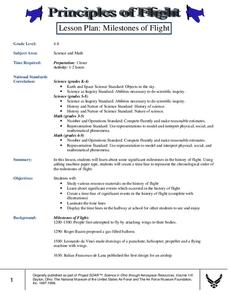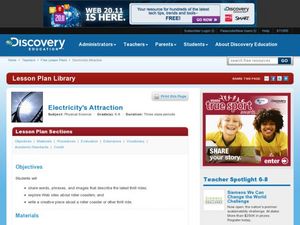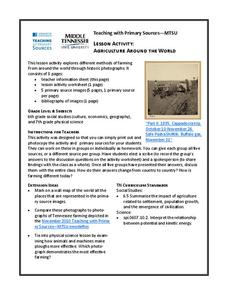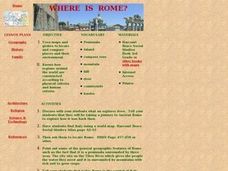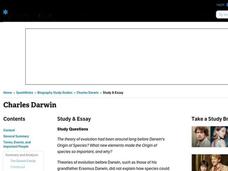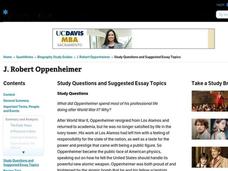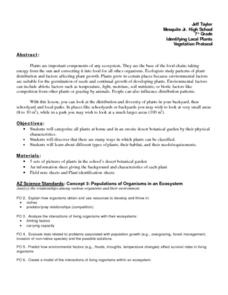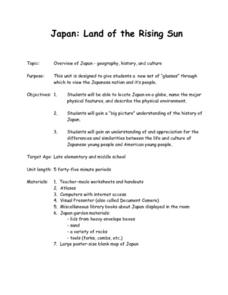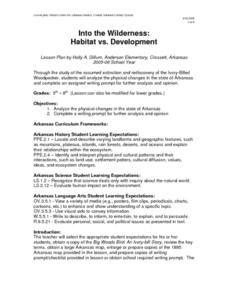Curated OER
Aboriginal Peoples And The Universals of Culture
Sixth graders research specific features of a province or territory of Canada. In this Canadian history lesson, 6th graders identify aboriginal culture areas on a map, identify cultural features represented in their region, and create...
Curated OER
Max Planck Study Questions
In this online interactive history worksheet, students respond to 10 short answer and essay questions about the accomplishments of Max Plank. Students may check some of their answers on the interactive worksheet.
Curated OER
Milestones of Flight
Learners identify significant milestones in the history of flight. In this aviation history lesson plan, students study various resource materials and construct timelines of significant achievements.
Curated OER
Teaching Fundamental Movement
Students perform fundamental movement activities for flexibility and motor skills. For this movement lesson plan, students perform physical activity for all grade levels.
Curated OER
Religion and Ethics: Living with Special Needs
Students explore human behavior by exploring mental and physical disabilities. In this learning disability lesson plan, students identify the different disabilities students have which prevent them from working at the same pace as the...
Curated OER
The Ups and Downs of Technology
Students create a visual timeline of skyscrapers built in the past 20 years. In this physical science lesson, students research important facts about the building. They discuss the challenges architects face when building skyscrapers.
Curated OER
Ship of the Line
Students discover boats by researching 18th century ships. In this Naval history lesson, students identify and describe the different components of an 18th century naval ship after researching information on the Internet. Students...
Curated OER
How Things Fly
Students will examine the physics of flight through using experimental inquiry. In this lesson, you'll introduce your students to the four forces of flight--drag, lift, thrust, and weight--through a variety of fun-filled flight...
Curated OER
Electricity's Attraction
Learners explore the different features of a roller coaster using an interactive website. In this physical science lesson, students explain the role of science to make this thrill ride possible. They develop a creative presentation about...
Curated OER
Agriculture Around the World
Students explore various kinds of farming methods around the world. In this history lesson, students view pictures of farming methods, then compare and contrast them in a class discussion with the methods of farming that are used today.
Curated OER
Understanding Newton's Laws
In this physics learning exercise, students investigate Newton's Three Laws. In this multiple choice, matching, and short answer learning exercise, student answer eleven questions.
Curated OER
Health Enhancement Traditional Games
Fourth graders participate in Tribal games. In this tribal nations activity, 4th graders play games that help improve on the physical skills for survival, invention, and problem solving. They discuss what is needed for survival and how...
Curated OER
Simple Harmonic Motion with Dr. DAQ
Young scholars study the work and accomplishment of Galileo. In this physics lesson, students calculate the period of a pendulum's using a mathematical equation. They explain the different factors affecting its period.
Curated OER
Electromagnetic Bomb (E-Bomb)
Students explain how E-bomb works. In this physics lesson, students simulate the effects of e-bombs on electronic targets. They discuss its potential harmful effects when used as a weapon.
Curated OER
Who is the Real Roman?
High schoolers describe what everyday life was like in ancient Rome and identify the various classes of people living in ancient Rome. They participate in a game called "The Real Roman," role-playing and trying to convince the class...
Curated OER
Where Is Rome?
Third graders discover Ancient Rome through maps and worksheets. In this world history lesson, 3rd graders locate Rome on a world map and identify the scope of the Roman Empire. Students label an entire map of Italy after printing one...
Curated OER
Charles Darwin
In this online interactive history activity, high schoolers respond to 9 short answer and essay questions about Charles Darwin. Students may check some of their answers on the interactive activity.
Curated OER
J. Robert Oppenheimer
In this online interactive history instructional activity, students respond to 10 short answer and essay questions about the accomplishments of J. Robert Oppenheimer. Students may check some of their answers on the interactive...
Curated OER
Pressure
In this physics activity, students use the clues at the bottom of the sheet to complete the crossword related to pressure. There are 15 clues to solve in the puzzle.
Curated OER
U.S. History: Antebellum Heroes and Villains
Eighth graders research and write reports on key figures of the Antebellum Period. The projects also include pictures, bibliographies, and timelines about their assigned figure. In addition, 8th graders present oral reports to classmates.
Curated OER
Confronting Two Challenges--One Physical, One Intellectual
Students examine the challenges of a new language and culture. In this cultural lesson, student read Running by Peter Hessler and discuss obstacles faced, including the language barrier. Students write an essay about a time they...
Curated OER
Japan: Land of the Rising Sun
Learners locate Japan on a globe, name the major physical features, and describe the physical environment. They survey the differences and similarities between the life and culture of Japanese young people and American young people.
Curated OER
Into the Wilderness: Habitat vs. Development
By studying the once-assumed extinction, then rediscovery of the Ivory-Billed Woodpecker, learners look at the physical changes that have occured in habitats throughout Arkansas. This outstanding lesson is chock full of terrific...
Curated OER
Mission System of Texas
Students create a storybook about Texas missions including the history of why they were built. They research and create pictures depicting how and why the missions were built. They write and illustrate the primary groups of people found...




